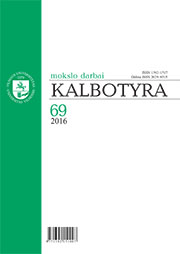Epistemic qualifications of the English marker likely and its equivalents in Lithuanian
Epistemic qualifications of the English marker likely and its equivalents in Lithuanian
Author(s): Anna RuskanSubject(s): Lexis, Semantics, Comparative Linguistics, Translation Studies
Published by: Vilniaus Universiteto Leidykla
Keywords: epistemicity; evidentiality; epistemic modality; epistemic evidential overlap; complementation; adverbial;
Summary/Abstract: The current study focuses on the epistemic qualifications realised by the English adjective and adverb likely and its equivalents in Lithuanian panašu ‘likely, it seems’ and tikėtina ‘believable, likely’, which derive from the semantic domain of comparison and belief. The aim of the study is to identify the functional similarities and differences of the markers in terms of their frequency, syntactic features (Complement-Taking-Predicates (CTPs), adverbials), functions, collocational profile and type of discourse (academic, newspaper). The English and Lithuanian data were drawn from the monolingual corpora, namely the Corpus of Contemporary American English (COCA), Corpus of the Contemporary Lithuanian Language (CCLL), Corpus of Academic Lithuanian (CorALit) and the bidirectional parallel corpus ParaCorp EN-LT-EN. The quantitative and qualitative findings reveal that the closest cross-linguistic CTP and adverbial equivalents are likely and tikėtina ‘believable, likely’ because they are most frequent in formal registers (academic, newspaper discourse) and display similar collocational profiles and contexts of use. In contexts with explicit evidence and argumentation, they may acquire evidential functions. Although the CTP and adverbial panašu ‘likely, it seems’ shares similarities with likely and tikėtina ‘believable, likely’ in expressing the author’s degree of probability, it shows a different semantic profile from the latter due to its conceptual link with the original meaning of similarity and appearances. The study shows how markers that derive from the semantic domain of comparison vary in functional distribution in present-day English and Lithuanian and introduces their functional equivalents deriving from a different semantic domain.
Journal: Kalbotyra
- Issue Year: 2016
- Issue No: 69
- Page Range: 179-204
- Page Count: 26
- Language: English

